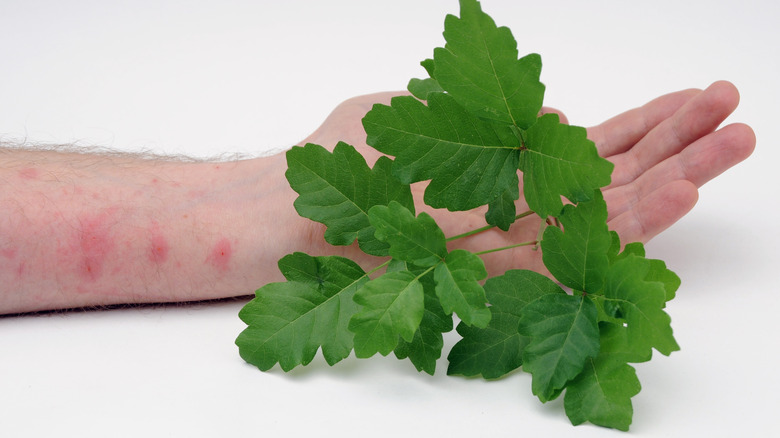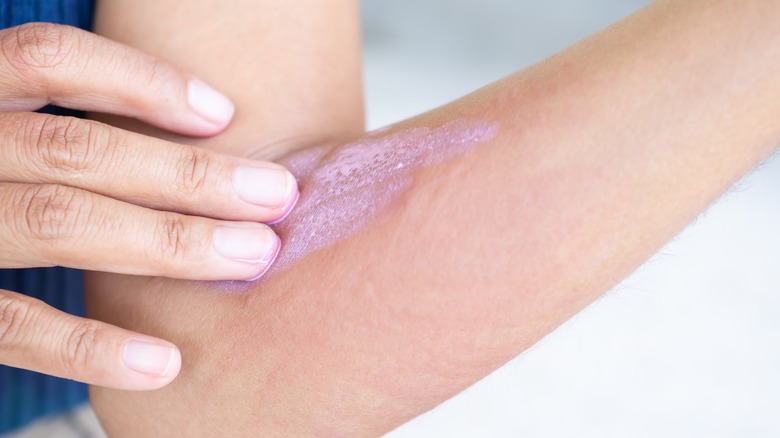How To Treat Poison Oak Rashes
Whether you were playing in the backyard or running around outside at recess, a parent, teacher, or camp counselor likely warned you about poison ivy at some point during childhood. However, poison ivy isn't the only plant that can produce an itchy, red rash when touched (via American Academy of Dermatology Association). Both found in wooded and swampy regions across the country, poison oak and poison ivy seem nearly identical at first glance (per WebMD). They're both thornless, can grow in clusters of three, may sport white flowers or red berries, and each can grow as a vine or a bush, according to Indigo Health. Even so, there are marked differences between the two plants. Here's how to recognize poison oak should you stumble upon it.
Poison ivy is usually bright green in color with smooth, rounded leaves or slightly grooved edges (per Indigo Health). In contrast, poison oak has dull, lobed leaves with hair on either side. The culprit behind a poison oak rash is an oil called urushiol, explains WebMD. Able to stick to our skin within minutes of having made contact with the plant, urushiol can cause streaky or patchy rashes, itchiness, redness, and blisters. Usually forming within one to three days after contact, a poison oak rash can stick around for up to three weeks.
At-home treatment of poison oak rashes
Treatment for a poison oak rash will depend on the severity of symptoms. Those who experience a severe allergic reaction should seek immediate emergency medical care if they experience breathing difficulties, trouble swallowing, facial swelling, fever, severe itching, or rashes that form around the mouth, eyes, genitals, or the majority of the body (per American Academy of Dermatology Association).
For more mild cases, treatment will involve soothing symptoms as the rash heals and can be done at home. The American Academy of Dermatology Association advises washing your hands promptly with warm water and soap after contact with poison oak in order to prevent transferring the oil to others or additional areas of the body. You'll also want to thoroughly wash any clothing, pets, or items that may have come in contact with the plant as well, as urushiol can stay active on surfaces for as many as five years, reports the U.S. Centers for Disease Control and Prevention (CDC). Be sure to wear gloves when washing and handling items.
Preventative measures to take while outdoors
The use of a cool compress, antihistamine pills, calamine lotion, or hydrocortisone cream can help relieve any itching (via American Academy of Dermatology Association). In addition, taking a cool shower or a mildly warm colloidal oatmeal bath can help alleviate discomfort from a poison oak rash. Just remember to keep your wash time short. Above all, you'll want to refrain from scratching or picking at blisters to reduce the risk of infection.
However, direct skin contact isn't the only way poison oak can affect your health. Rather, the CDC cautions against burning poisonous oak plants, as doing so can cause severe respiratory distress if we breathe in the smoke. Remember to wear protective clothing while outdoors, such as long pants and boots, to help reduce the chances of direct contact with a poison oak plant (per WebMD). Over 80% of people have an allergic response to urushiol. Therefore, if rashes have not improved within a week to 10 days, be sure to consult with your healthcare provider, advises the American Academy of Dermatology Association.



